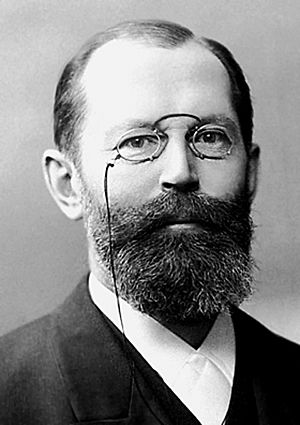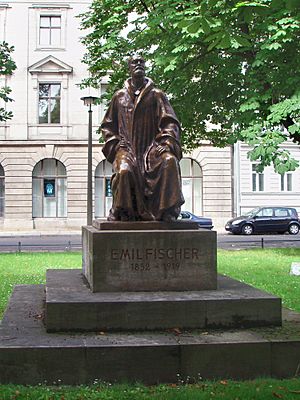Emil Fischer facts for kids
Quick facts for kids
Hermann Emil Fischer
|
|
|---|---|

Fischer c. 1895
|
|
| Born |
Hermann Emil Louis Fischer
9 October 1852 Euskirchen, Rhine Province
|
| Died | 15 July 1919 (aged 66) |
| Nationality | German |
| Alma mater | University of Bonn University of Strasbourg |
| Known for | Study of sugars & purines |
| Awards |
|
| Scientific career | |
| Fields | Chemistry |
| Institutions | University of Munich (1875–81) University of Erlangen (1881–88) University of Würzburg (1888–92) University of Berlin (1892–1919) |
| Doctoral advisor | Adolf von Baeyer Friedrich August Kekulé |
| Doctoral students | Alfred Stock Otto Diels Otto Ruff Walter A. Jacobs Ludwig Knorr Oskar Piloty Julius Tafel |
Hermann Emil Louis Fischer (born October 9, 1852 – died July 15, 1919) was a German chemist. He won the Nobel Prize in Chemistry in 1902. He is famous for discovering the Fischer esterification, a way to make esters. He also created the Fischer projection, which is a special drawing method for molecules. This method helps chemists understand how atoms are arranged in 3D space. Fischer also suggested the "lock and key" idea for how enzymes work. Even though his full name was Hermann Emil Louis Fischer, he was always known as Emil Fischer.
Contents
Emil Fischer's Early Life and Education
Emil Fischer was born in Euskirchen, a town near Cologne, Germany. His father, Laurenz Fischer, was a businessman. Emil first wanted to study science. However, his father made him work in the family business. After some time, his father realized Emil was not suited for business.
In 1871, Emil started studying at the University of Bonn. A year later, in 1872, he moved to the University of Strasbourg. He earned his doctorate degree in 1874. His main teacher there was Adolf von Baeyer. Fischer studied a group of chemicals called phthaleins for his doctorate. After finishing his studies, he got a job at the university.
Fischer's Career at Different Universities
After working for eight years in Strasbourg, Emil Fischer became a professor of chemistry. He taught at the University of Erlangen starting in 1882. Then, in 1885, he moved to the University of Würzburg.
In 1892, he took over from another famous chemist, August Wilhelm von Hofmann. Fischer became a chemistry professor at the University of Berlin. He stayed there until he died in 1919.
Fischer's Family Life
Emil Fischer married Agnes Gerlach in 1888. Sadly, she passed away seven years later. They had three sons together. Two of his younger sons died while serving in the military during World War I. His oldest son, Hermann Otto Laurenz Fischer, also became an organic chemist. Emil Fischer died in Berlin on July 15, 1919, when he was 66 years old.
Fischer's Important Discoveries in Chemistry
Emil Fischer made many important discoveries in chemistry. He was especially known for his work on sugars and other complex molecules.
Hydrazine and Indigo Research
In 1875, Fischer discovered new organic compounds called hydrazine derivatives. He studied how these compounds reacted with other substances. He found that they easily combined to form many new chemicals.
One important reaction involved hydrazines reacting with aldehydes and ketones to form hydrazones. In 1886, he showed that these hydrazones could be changed into substances related to indole. Indole is the basic structure of indigo, a famous blue dye. This work helped confirm ideas about indigo.
Studies on Dyes and Purines
Fischer also studied fuchsine dyes, which are bright magenta colors. Working with his cousin Otto Fischer, he published papers in 1878 and 1879. They showed that these dyes were related to triphenylmethane.
Next, Fischer focused on compounds similar to uric acid. He greatly expanded the knowledge of purines. In 1881 and 1882, he published papers that showed the chemical structures of uric acid, xanthine, caffeine, and theobromine. He even made caffeine in the lab for the first time. Later, he prepared many other purine compounds. Some of these were even patented for possible medical uses.
Breakthroughs in Sugar Chemistry
Fischer is most famous for his work on sugars. Early in his career, he found that phenylhydrazine reacted with sugars to create substances called osazones. These osazones were easy to form and had clear crystal shapes. This made it much easier to identify different types of sugars.
He also successfully made D-(+)-glucose in the lab. He figured out how to draw the structures of all 16 different types of glucose molecules that can exist. He even made several of these different forms. This work helped prove the Le Bel–Van 't Hoff rule, which explains how asymmetric carbon atoms affect a molecule's shape.
Enzymes and the "Lock and Key" Model
In the field of enzymology, which is the study of enzymes, Fischer proposed a famous idea. He suggested the "lock and key" model. This model explains that an enzyme (the "lock") has a specific shape that only fits a certain molecule (the "key"). This helps the enzyme do its job very precisely.
Barbiturates and Proteins
Fischer also played a role in discovering barbiturates. These are medicines used to help with sleep, epilepsy, anxiety, and anesthesia. In 1904, he worked with a doctor named Josef von Mering to launch the first barbiturate medicine, called barbital.
Later, he did important work on proteins. He developed new ways to break down complex proteins into smaller parts called amino acids. He then found ways to put these amino acids back together to create new synthetic peptides. These lab-made peptides were very similar to natural proteins. His research from 1899 to 1906 was published in a book in 1907.
Awards and Legacy

In 1897, Emil Fischer suggested creating the International Atomic Weights Commission. This group helps set standard atomic weights for elements. In 1899, he was chosen as a Foreign Member of the Royal Society in London.
He received the 1902 Nobel Prize in Chemistry. The prize was given to him "in recognition of the extraordinary services he has rendered by his work on sugar and purine syntheses." This means he was honored for his amazing work on how to make sugars and purines in the lab.
Many chemical reactions and ideas are named after him:
- Fischer indole synthesis
- Fischer projection
- Fischer oxazole synthesis
- Fischer peptide synthesis
- Fischer phenylhydrazine and oxazone reaction
- Fischer–Speier esterification
- Fischer glycosidation
- Kiliani–Fischer synthesis
It's important to know that the Fischer–Tropsch process is named after a different chemist, Franz Joseph Emil Fischer. He was not related to Hermann Emil Fischer.
See also
 In Spanish: Hermann Emil Fischer para niños
In Spanish: Hermann Emil Fischer para niños
- Hermann Otto Laurenz Fischer (his son, also a chemist)

